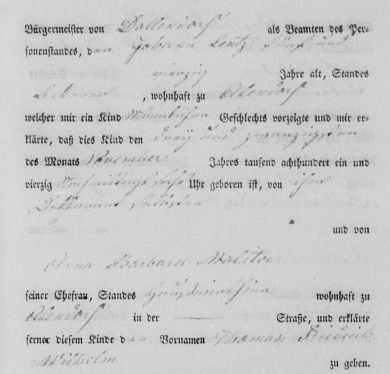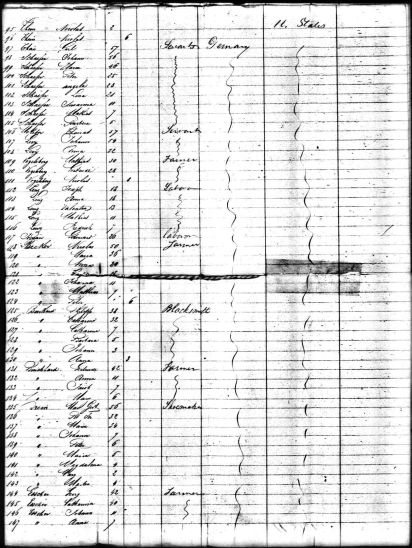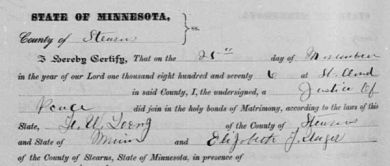Background
For some time now questions have surrounded the relationship of Frederick William Thomas Lenz of Stearns County, Minnesota to the family of Johann Lenz and Anna Barbara Molitor that immigrated in 1852 to Burlington, Wisconsin. Previous research by others has provided record of his baptism in St. Agatha's church in Alendorf, his transatlantic voyage with his parents, and his death in 1919 in Westby township, Divide County, North Dakota.
In the Lenz Newsletter of 1 June, 2007, Wilfred Metz summarized the known facts regarding Frederick Lenz, presenting, in my opinion, sufficient evidence to prove the relationship beyond any question. It is not my purpose to review all these data in this article. However, I will point out some unfortunate errors in recording key pieces of information which have served to cloud the relationship, but on closer scrutiny and comparison with known facts the relationship is clear.
Additional Information of Frederick Lenz' Birth
If one good thing came from the Napoleonic Wars in Europe, it was the adoption of the French method of civil registration. This required prompt registration of births, marriages, and deaths with seemingly minute detail to appropriate officials. An unwelcome intrusion into the lives of those in occupied Europe, but a boon to those of us who came after them, trying to find record of their lives.
The registration of Friedrich's birth was made by his father, Johann Lenz before the Bürgermeister of Dollendorf on the 24th of November. Johan states he is a 45 years old, a farmer, and resident of Alendorf, and his wife is Anna Barbara Molitor. The registration was signed by the Bürgermeister, Johann Lenz (signed Lentz), and two witnesses who are named as Peter Peiss, a shoemaker, and Henrich Schneider, a farmer, in the documents. On this document Frederick's name is recorded as "Thomas Friedrich Wilhelm" rather than "Friedrich Wilhem Thomas."
Emigration
When the family left for the United States, they sailed from Antwerp on the S.S. Antarctic, arriving in New York on 3 September, 1852. The passenger list records Johann and Anna on lines 107-108, and the children on lines 112-116. The children are listed as: Joseph, Anna, Valentin, Mathias, and Fredrich. These children are the five youngest children of Johann and Barbara. Until now, this was believed to be the last time that the Frederick appeared with the rest of the family.
New Discovery
At first glance, a the Lenz family does not appear to be recorded in the 1860 census. However, a closer examination shows the family is there, but the surname is incorrectly recorded as. It wasn't until I made a line by lin search that I located them. On page 127 of the census of Brighton, Kenosha County, Wisconsin, the family of John Likely is recorded as follows:
- John Likely, age 66 [1794], male, white, farmer, born Prussia
- Barbara Likely, 60 [1800], female, white, born Prussia
- Nickola Likely, 26 [1834], male, white, farm laborer, born Prussia
- Gertrude Likely, 25 [1835], female, white, servant, born Prussia
- Peter Likely, 22 [1838], male, white, laborer, born Prussia
- Valentine Likely, 21 [1839], male, white, laborer, born Prussia
- Mathias Likely, 20 [1840], male, white, laborer, born Prussia
- William Likely, 19 [1841], male, white, laborer, born Prussia
When this family is examined as a whole, it apparently matches quite well with what is known about composition of the Lenz family. However, there are a few caveats that need to be considered when evaluating this record.
- The age of the parents. If we assume the birth and enumeration (5 July 1860) dates are correct, Johan would be 64 years old, and Anna Barbara would be 59 years old. According to the census, John is 66, and his wife 60, so the dates are off, but within two years of being exact, so they are reasonably close.
- Ages of the children. With two exceptions, the ages of the younger people in this household are different from what would be expected. Only the ages for Matias and William match the expected age with reasonable accuracy. Mathias would have been 20 years and 10 months, and Frederick would have been 18 years and 7 months.
- Children who were married before this census. It would be assumed they were not present in the household, as they had established their own separate residences. Anna Gertrude was married in 1852; Nickolaus in 1857; Peter in 1857; Thomas in 1858; Anna Catherine in 1854, and Valentine in January 1860. Of these, this enumeration lists Nickola, Gertrude, Peter, and Valentine. None of these names are unusual among the Germans who settled in this part of Wisconsin.
- Listed occupations. John is listed as being a farmer, and his wife has none listed, which is not unusual. Nickola is farm laborer, Gertrude a servant, and Peter, Valentine, and Mathias are listed as laborers. William is the only who does not have an occupation listed, even though he is older than the age for which occupations were to be recorded.
- This family does not appear in any prior or subsequent census which increases the possibility that there is an error in the recording of the surname.
Analysis
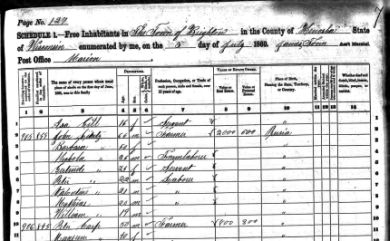
(Click on the image to see a closeup or
click here to see a larger image of the entire page).
Based on these facts, I propose that the family presented here is the Lenz household, but only the last two persons enumerated, Mathias and William, are their children. The other four persons are hired staff working for the family. The error in the spelling of the surname was obviously introduced by the recorder, either at the time he recorded the information owing to inaccurate reporting from the individual who supplied the information or when he transcribed it on the enumeration form. Even with these reservations, I feel this provides sufficient proof to link Frederick to the family after their arrival in the United States.
In Newton Winchell's History of the Upper Mississippi Valley, he states the following:
Frederick W. Lenz dates his birth in Prussia, on the 22d of November, 1841. He came to America with his parents, who located in Kenosha county, Wisconsin, in 1850. In 1860, they removed to Belle Plaine, Scott county, Minnesota, and the following year, to St. Peter (Mitchell, 478).
I believe that this quote has caused some people to think that the Thomas Lenz who is living in Belle Plaine at the time of the 1860 census is the same Frederick Lenz. Granted, both men are married to women named Elizabeth, but the Scott County Thomas Lenz is actually Frederick's brother. Thomas' family is in Scott County in 1870 and 1880, when the whereabouts of Frederick Lenz are known to be in Stearns County. Thomas and his wife remained in Scott County until their deaths. There is also some confusion caused by the phrase "they removed to Belle Plaine." The initial impression is that Frederick and his family moved en masse to Scott County, Minnesota but this is clearly untrue, as Johann and Barbara are known to have remained in Kenosha County, Wisconsin.
Family
Frederick and Mary had three additional children after the 1870 census. They were: Peter William (14 Nov 1871-22 Nov 1889), Johannes Michael (15 Sep 1873-15 Jan 1950), and Luisa (11 Jul 1875-6 April 1877). According to Winchell, Mary died on 17 January 1876, but I have not been able to locate a death record for her in the Stearns County vital records. On 25 November 1876 Frederick married Elizabeth Dorothea Unger, who was, the widow of a Mr. Brown. Elizabeth reportedly had three children with her first husband, John (1862-1929), Catherine (1866-1920), and Elizabeth (1868-1874). I have not been able to locate deaths for Mr. Brown and his daughter Elizabeth in the Stearns vital records. according to Winchell, Frederick and Elizabeth were married 6 November 1878, but this is clearly incorrect, as the marriage record is clearly dated 25 November 1876. This marriage was performed in St. Cloud by Nathan Barnes, a Justice of the Peace, and recorded by the county clerk 6 December 1876.
Frederik Lenz was a very industrious fellow. In 1861 Frederick moved to St. Peter, Nicollet County where he taught school for three years. In 1864, he to Stearns County where he taught one year at Richmond, one year at Spring Hill, and then at St. Martin, where he met and married Mary Schoenborn. In 1867, he settled in Section 22 of Spring Hill Township where built a hotel at Stony Creek to service the stage coach lines and served as first postmaster in September of 1867. He also drafted and circulated a petition for the organization of Spring Hill Township. In 1870 and 1880 he reported his occupation as farmer, in 1900 an auctioneer, and in 1910 a lawyer in general practice.
During the smallpox epidemic of 1881, the St. Cloud Times reported nine cases of smallpox in the Lenz household, including one death. Alfred G. Jaques, an insurance agent in Sauk Center and Stearns County Commisioner, reported his "praise of the assistance received by him of F. W. Lenz and H. S. Ley of Spring Hill and all other committees for visiting the infected localities."
During this time, the Melrose Record reported that Frederick went to Melrose with a pass issued by Dr. DuBois, a physician from St. Paul, who had been summoned to Stearns County to assist with treatment of the sick during this outbreak. Evidently the pass was written in German, as the town marshall could not read it, and led Frederick through town by his collar until he could find someone who could read it. The press called on the city officials to appoint a new marshall, who could read and write, in English and German.
Frederick seems to have led a rather peripatetic life. Born in Germany in 1841, he immigrated to the United States in 1852 and settles with his parents in Wisconsin. By 1861 he had set out on his own for Minnesota, moving to Nicollet County, and then to Stearns County in 1864, living in Richmond, then Spring Hill. In 1870, Frederick is in St. Martin Township, Stearns County with his wife, Mary Elisabeth Schoenborn, and their two children, Mary and Benedict Christian. In 1875 Frederick's family is in Melrose, in 1880 & 1885, Spring Hill; 1895 & 1900, Belgrade; and in 1910, South Haven, Wright County with his daughter, Theresia Wesseling and her family. They move to Divide County, North Dakota, where Frederick dies.
Results
We now have even more conclusive evidence to link Frederick to the rest of the Lenz family, completing a genealogical mystery that has persisted for generations. For me, this clears up the questions I had regarding the biggest "mystery man" on my pedigree. Which, interestingly enough, has only been there for a little over two years—but that's another story.
Thanks to the reseach of others, I now have very good information on who his parents were. I have identified nearly 400 descendants of Frederick Lenz, and tied into an active family organization who can, I hope, benefit from my work as much as I have benefitted from theirs.
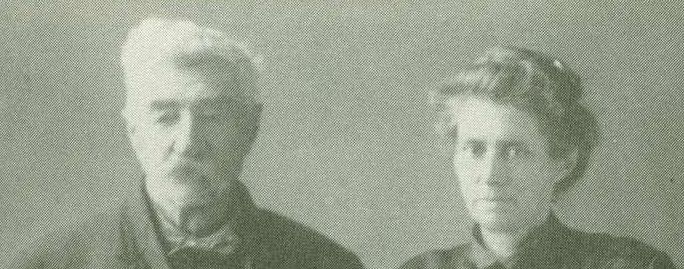
Frederick Lenz and his daughter, Mary Ann Winter (1867-1954), ca. 1915. Image scanned from Mary Gordian Miller, St. Michaels on the Hill, Waite Park, MN: Park Press, 1983, p. 84
This page last updated:
© 2008, Jeffrey M. Svare, AG®
